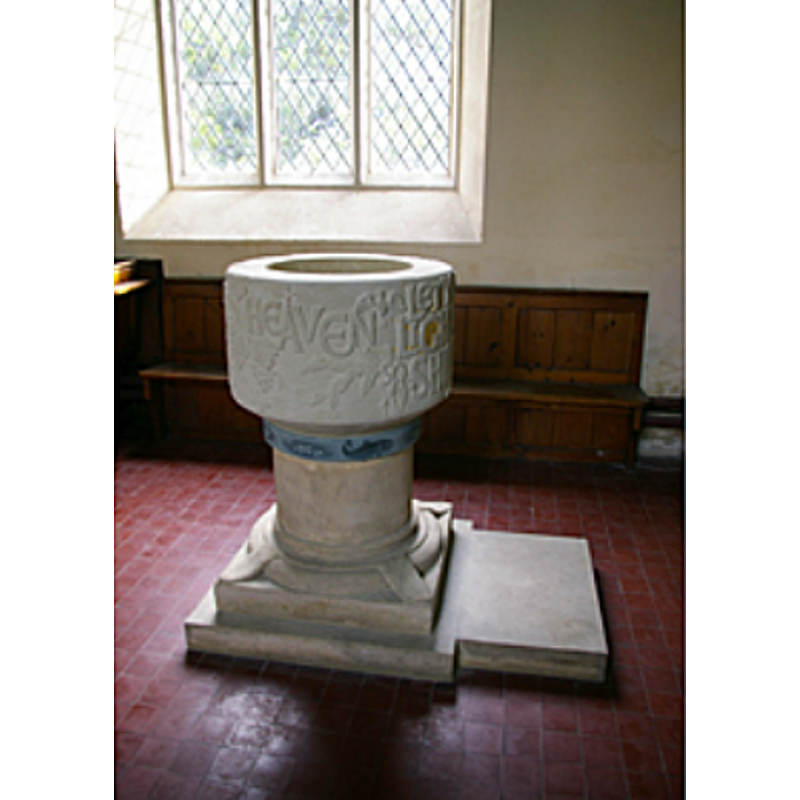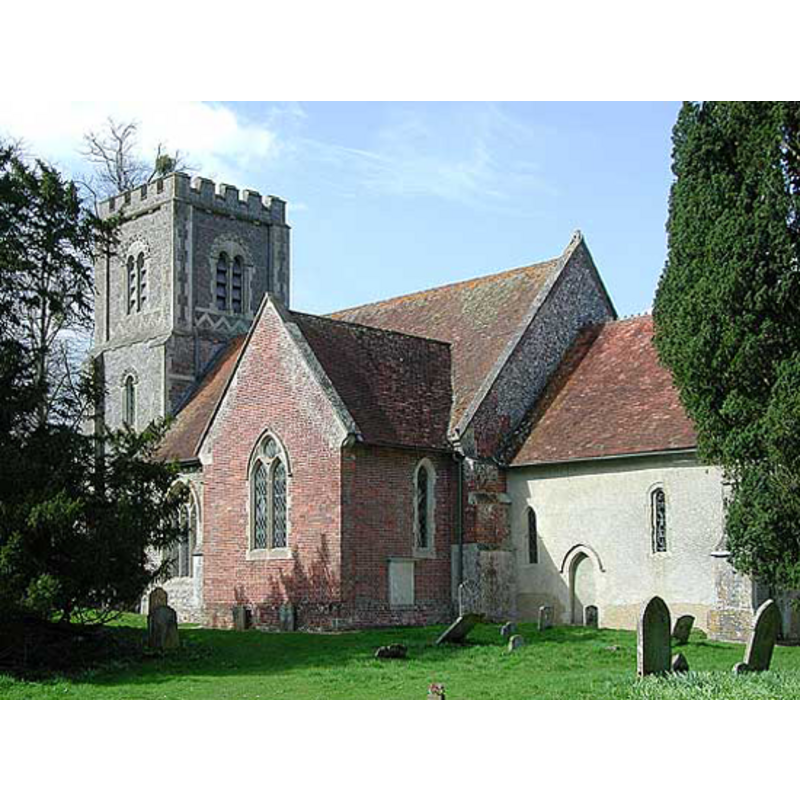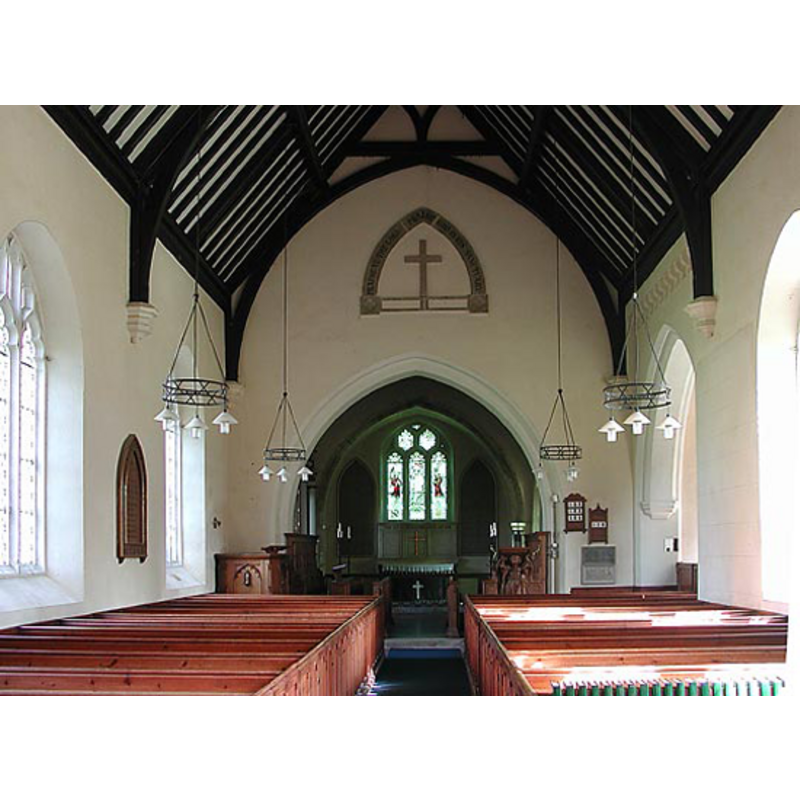Hurstbourne Priors / Eisseburn / Eisseburne / Hesseburna Prioris / Hissaburna / Hursborne Priors / Hussburne / Husseborne / Husseburna

Image copyright © Hurstbourne Priors Parish Council, 2008
No known copyright restriction / Fair Dealing
Results: 4 records
view of church exterior - southeast view
view of church interior - nave - looking east
view of font and cover
Scene Description: the re-cut basin on a new (?) base [NB: the is new base was used in August 2008 to support the modern basin made by a local artist -- one of the sources describes the base as old, the original, but, although it is in Romanesque style, it must be modern [cf. FontNotes]
Copyright Statement: Image copyright © Allan Soedring, 2011
Image Source: digital photograph taken by Allan Soedring [www.astoft.co.uk] [accessed 31 July 2011]
Copyright Instructions: Standing permission
view of font in context
Scene Description: Source caption: "A new Baptismal Font for St Andrew's Church was commissioned, designed and carved by Marilyn Smith, an artistic stone mason, who lives in Hurstbourne Priors. Funds raised from the celebration contributed towards the costs of carving and installing the new Font, and improving its setting in the church. The new Font installed in August 2008." [NB: the new basin is standing on the base that had been made earlier for the repaired old basin].
Copyright Statement: Image copyright © Hurstbourne Priors Parish Council, 2008
Image Source: digital photograph taken 14 September 2008, in the Parish Council site [www.hurstbournepriors-pc.org.uk/HurstbournePriorsParishCouncil/harry_plunket_greene-4458.aspx] [accessed 1 August 2018]
Copyright Instructions: No known copyright restriction / Fair Dealing
INFORMATION
FontID: 06758HUR
Object Type: Baptismal Font1
Church/Chapel: Parish Church of St. Andrew the Apostle
Church Patron Saints: St. Andrew
Church Location: Hurstbourne Priors, Whitchurch RG28 7SB, UK
Country Name: England
Location: Hampshire, South East
Directions to Site: Located off the B3048-B3400 crossroads, about 3 km SW of Whitchurch, 7 km E of Andover
Ecclesiastic Region: Diocese of Winchester
Historical Region: Hundred of Evingar
Font Location in Church: Buried in the churchyard in September 2008 [cf. FontNotes]
Century and Period: 12th - 13th century, Medieval
Credit and Acknowledgements: We are grateful to Allan Soedring, of www.astoft.co.uk, for his photographs of this church and font
Church Notes: original church here said to be ca. 800 -- the National Gazetteer of 1868 gives the dedication of the church as St. John; all other sources appear to have St. Andrew
Font Notes:
Click to view
There is an entry for Hurstbourne [Priors] [variant spelling] in the Domesday survey [http://opendomesday.org/place/SU4346/hurstbourne-priors/] [accessed 1 August 2018]; it reports "1 church. 1.0 church lands" in it. Cox & Harvey (1907) list a baptismal font of the Norman period here. The Victoria County History (Hampshire, vol. 4, 1911) notes: "A church is known to have existed at Hurstbourne in very early times, as a charter of Bishop Denewulf dated 802 refers to its consecration in that year. [...] The oldest portion of the [present] building is the chancel, which is of 13th-century date; but there are two arches, which show that there was formerly a 12th-century building here: one of these is now the west doorway of the tower, and the other is the entrance to the north chapel from the chancel. This appears to have once been the chancel arch, which was probably moved to its present position, and the present arch formed, when the north chapel was built in the 16th century." There is no mention of a font in the VCH. The Hurstbourne Priors Parish Council website [http://www.hurstbournepriors-pc.gov.uk/villageamenities/st_andrew_s_church.asp#item1062] includes reports of a state of the old font, by Canon Martin Coppen, the incumbent, and a proposal for a new font and a timeline for its fabrication, by Marilyn Smith (Carver and Gilder). The old font -"12th century Norman work, constructed of Caen stone"- had been reported (ibid.) in June 2002: "Much concern about the aesthetic state and safety of the old Font which now has a crack on its lip. Font expert, Andrew Ball MSc, visited and reported that, while the old Font could be repaired by conservation techniques, this would initially cost over £1500 and even more when the three rusted iron cramps were removed and internal damage assessed. The report recommends that it would be better to put the money towards commissioning a new Font for the Church." Further details of the process are given in a timeline written by the same M. Coppen (ibid.) Details of the design and execution of the work are given in the timeline by Coppen, with date of completion and installation in September 2008, and first baptism in the new font in October of the same year. The document (ibid.) adds an entry for 17 September 2008: "Burial with prayers of the old Font in Hurstbourne Priors Churchyard." The Annual Report of the Parish Council for the year ending 31 December 2010 [www.hurstbournepriors-pc.gov.uk/_assets/villageamenities/annrept2010.pdf] notes: "The balance of £2,510 in the restricted Fabric Fund belongs to the Font Fund which the PCC plans to put towards improving the area around the new font", thereby indicating that the new font was already fully functioning in the church. [NB: the old font image we accessed [Astoft...] shows a restored or re-cut font; did the church actually restore the font before burying it?] David Ross, of Britain Express Ltd [www.britainexpress.com/counties/hampshire/churches/hurstbourne-priors.htm] [accessed 1 August 2018] writes: "The font was installed in 2006, and placed on the original 12th century base. It replaces a Norman font, made of Caen stone, decorated with irregular chevron carvings. That font unfortunately deteriorated from the rusted iron straps used to reinforce the bowl." The entry for this church in Historic England [Listing NGR: SU4356947224] reports: "The restored font has an old Norman top, with zig-zag ornament." The entry for this church in the CRSBI (2018) notes: "The church also houses a chevron-decorated font, probably 12thc rather than 19thc but grotesquely over restored. A new font carved by Marilyn Smith was installed in 2008. [...] At the W end of the nave on the S side. The bowl is tall and beaker-shaped and stands on a 19thc support consisting of a cylindrical shaft on a spurred attic base, on a square plinth and a step. The bowl is carved with horizontal chevron bands encircling it. Their profile, from top to bottom, is as follows:
(i) A row of flat chevron teeth pointing downwards, with a step around the lower edges.
(ii) A roll, a groove and a thin quadrant.
(iii) A roll with a double-quirk below it.
(iv) A roll.
(v) A broad, flat fillet, stepped above and below.
(vii) A row of flat chevron teeth pointing upwards.
The chevron is extremely irregularly laid out, and runs out of phase at various points. In the worst of these, towards the NE, a vertical leaf-shape has been carved to fill a particularly awkward gap between elements (iii) and (iv). A horizontal crack runs around the bowl just below the middle, and another runs vertically from it to the rim on the S side. Both have been repaired with iron clamps. It is not conventionally lined, but a small stone bowl has been inserted inside the basin to reduce its capacity. The font is in very poor condition, despite its pristine appearance, which must be due to a dramatic recutting in the 19thc. Inserted repairs on the rim mark the damage caused by the removal of staples for locks [...] The font is heavily recut, but probably of a similar date to the other Romanesque work here. Pevsner makes no mention of it."
COORDINATES
Church Latitude & Longitude Decimal: 51.2174, -1.375
Church Latitude & Longitude DMS: 51° 13′ 2.64″ N, 1° 22′ 30″ W
UTM: 30U 613489 5675256
MEDIUM AND MEASUREMENTS
Material: stone
Diameter (inside rim): 58 cm*
Diameter (includes rim): 70 cm*
Basin Total Height: 58.5 cm
Notes on Measurements: * CRSBI (2018)
REFERENCES
The National Gazetteer: a Topographical Dictionary of the British Isles, London: Virtue & Co., 1868
Victoria County History [online], University of London, 1993-. Accessed: 2011-07-26 00:00:00. URL: https://www.british-history.ac.uk.
Corpus of Romanesque Sculpture in Britain and Ireland, The Corpus of Romanesque Sculpture in Britain and Ireland, The Corpus of Romanesque Sculpture in Britain and Ireland. Accessed: 2018-08-01 00:00:00. URL: http://www.crsbi.ac.uk.
Cox, John Charles, English Church Furniture, New York: E.P. Dutton & Co., 1907


![the re-cut basin on a new (?) base [NB: the is new base was used in August 2008 to support the modern basin made by a local artist -- one of the sources describes the base as old, the original, but, although it is in Romanesque style, it must be modern [cf. FontNotes]](/static-50478a99ec6f36a15d6234548c59f63da52304e5/compressed/1110731021_compressed.png)